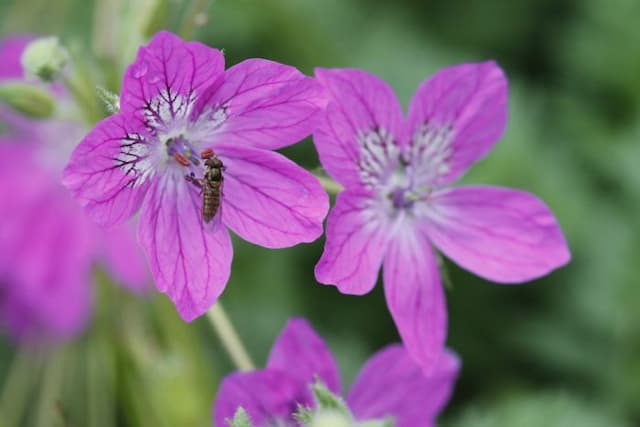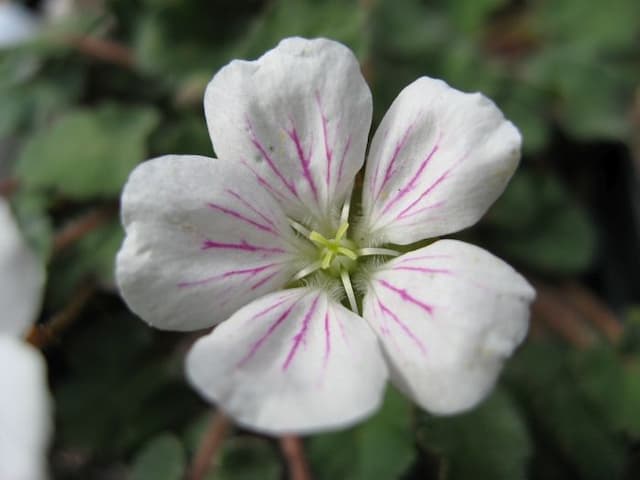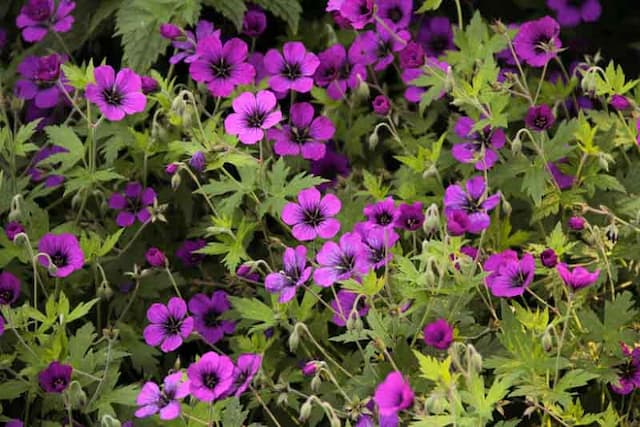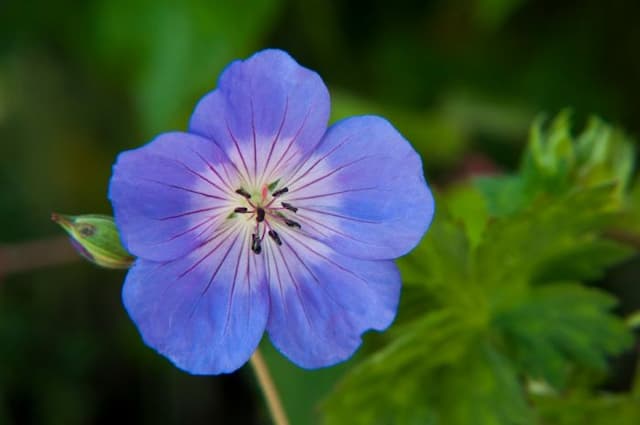Bigroot Geranium Geranium macrorrhizum 'Velebit'

ABOUT
The plant known as the Velebit geranium features a lush, low-growing spread of fragrant foliage. The leaves are rounded with distinct lobes and a rich green hue, often showing hints of red in cooler temperatures. This foliage creates a dense mat, making it an excellent ground cover. Through the flowering season, the Velebit geranium produces clusters of pink to purplish flowers, which rise subtly above the leaves on thin stems. Each flower has five petals, rounded and slightly veined, adding a delicate yet hardy splash of color to gardens. The visual appeal is complemented by the aromatic leaves that release a strong scent when brushed or crushed. The plant's overall growth habit is such that it can unify garden layouts, working seamlessly with other plants to create a cohesive landscape design.
About this plant
 Names
NamesFamily
Geraniaceae.
Synonyms
Bigroot Geranium, Bulgarian Geranium, Rock Crane's-bill.
Common names
Geranium macrorrhizum 'Velebit'.
 Toxicity
ToxicityTo humans
The common name for Geranium macrorrhizum 'Velebit' is Bigroot Geranium. Bigroot Geranium is generally considered non-toxic to humans. Hence, ingestion of this plant is not expected to cause poisoning or adverse symptoms. However, it is always advisable to be cautious and avoid consuming parts of ornamental plants not designated as food sources.
To pets
The Bigroot Geranium is not known to be toxic to pets. This means that if pets like dogs or cats ingest parts of this plant, they are unlikely to experience poisoning or severe adverse health effects. Regardless, monitoring pets and preventing them from eating non-food plants is good practice to avoid any potential digestive upset.
 Characteristics
CharacteristicsLife cycle
Perennials
Foliage type
Evergreen
Color of leaves
Green
Flower color
Pink
Height
1 feet 4 inches (40 cm)
Spread
1 feet 6 inches (45 cm)
Plant type
Herb
Hardiness zones
5
Native area
Balkans
Benefits
 General Benefits
General Benefits- Easy to grow – Geranium macrorrhizum 'Velebit', commonly known as Balkan cranesbill, is a low-maintenance perennial that thrives in various conditions.
- Drought-tolerant – Once established, this plant has good drought resistance, making it ideal for xeriscaping or dry gardens.
- Erosion control – It serves as an excellent ground cover, spreading quickly to stabilize soil and prevent erosion on slopes.
- Attracts pollinators – The flowers attract bees and other beneficial insects to the garden, which help in pollinating other plants.
- Deer and rabbit resistant – Balkan cranesbill is not favored by deer or rabbits, making it a good choice for gardens susceptible to these animals.
- Seasonal interest – With its attractive foliage and abundant pink to purple flowers, the plant adds color and texture to the landscape across seasons.
- Edging and bordering – Its compact growing habit makes it suitable for edging and bordering pathways or garden beds.
- Herbaceous perennial – As a perennial, it returns year after year, reducing the need for annual planting.
 Medical Properties
Medical Properties- Antibacterial: Contains compounds that may have antibacterial properties.
- Antifungal: May be effective in inhibiting the growth of certain fungi.
- Astringent: Plant extracts might be used for their astringent effects to tone skin or mucous membranes.
- Anti-inflammatory: Could be used to reduce inflammation due to its potential anti-inflammatory compounds.
 Air-purifying Qualities
Air-purifying QualitiesThis plant is not specifically known for air purifying qualities.
 Other Uses
Other Uses- Insect repellent: Geranium macrorrhizum can be used to repel insects due to its strong scent, which is pleasant to humans but offensive to many insects.
- Companion planting: The plant can be used in the garden to protect other plants from pests, thanks to its natural repellent properties.
- Garden aesthetics: With its attractive foliage and blooms, it is often used to enhance the visual appeal of borders, rock gardens, and ground covers.
- Crafts: Dried leaves and flowers of Geranium macrorrhizum can be used in potpourri to create a fragrant home accessory.
- Fabric dye: Historically, parts of the plant may have been used to create a natural dye for fabrics, imparting a gentle color.
- Soil erosion control: Its root system helps to prevent soil erosion, making it beneficial for planting on slopes and in areas with loose soil.
- Natural mulch: When pruned, the plant material can be used as mulch to enrich soil and suppress weeds around other garden plants.
- Floral arrangements: Fresh or dried flowers can be added to floral arrangements for a rustic touch and a mild scent.
- Culinary decoration: Although not commonly known for culinary uses, the flowers could be used as a decorative, edible garnish for certain dishes.
- Photography: Due to its picturesque qualities, Geranium macrorrhizum serves as a popular subject for botanical photography and plant studies.
Interesting Facts
 Feng Shui
Feng ShuiThe Bigroot Geranium is not used in Feng Shui practice.
 Zodiac Sign Compitability
Zodiac Sign CompitabilityThe Bigroot Geranium is not used in astrology practice.
 Plant Symbolism
Plant Symbolism- Health and Good Fortune: Geraniums in general are associated with health and positive energy, often considered a good omen for bringing good luck into the home.
- Friendship: The geranium plant is sometimes given as a gift to symbolize friendship or to express a desire for the recipient to have a healthy life filled with happiness.
- Sturdiness: The particular variety of Geranium macrorrhizum 'Velebit' is a hardy plant that can symbolize resilience and the ability to thrive in difficult conditions.
- Protection: Geraniums have been traditionally used to ward off evil spirits and are thought to offer protection due to their strong scent, which is believed to repel negative energy.
 Water
WaterBigroot geranium requires moderate watering, preferring the soil to be kept evenly moist but not waterlogged. During the growing season, water the plant with approximately 1 gallon of water per week, depending on the weather conditions. If rainfall is sufficient, you may not need to water it manually, but in periods of drought, increase watering to maintain soil moisture. Reduce watering in the winter when the plant is dormant. Always check the top inch of soil for dryness before watering to avoid overwatering.
 Light
LightThe Bigroot geranium thrives in partial shade to full sun. For optimal growth, plant it where it will receive morning sunlight and some afternoon shade, especially in hotter climates. Too much shade can reduce blooming and cause the plant to become leggy, while too much direct sun can lead to leaf scorch.
 Temperature
TemperatureBigroot geranium is tolerant of a wide range of temperatures and is hardy in USDA zones 4 through 8. They can survive minimum temperatures down to about -30 degrees Fahrenheit and are heat tolerant up to about 80 degrees Fahrenheit. The ideal temperature range for growing Bigroot geraniums is between 60 to 70 degrees Fahrenheit during the day.
 Pruning
PruningPrune Bigroot geranium to remove dead or yellowing leaves and to shape the plant, enhancing both its health and appearance. Pruning is best done in early spring or after flowering to encourage a second bloom. Cut back the foliage by one-third every few years to rejuvenate the plant. Deadhead spent flowers regularly to promote continuous blooming.
 Cleaning
CleaningAs needed
 Soil
SoilBigroot geranium thrives best in well-draining soil with a mixture of loam, peat, and perlite. The best pH for the soil ranges from neutral to slightly alkaline (pH 7.0 to 7.5).
 Repotting
RepottingBigroot geranium typically does not need frequent repotting; it can be repotted every 2 to 3 years or when it outgrows its current container.
 Humidity & Misting
Humidity & MistingBigroot geranium is adaptable to most humidity levels but prefers average household humidity; excessive humidity is not necessary.
 Suitable locations
Suitable locationsIndoor
Place in bright, indirect light.
Outdoor
Plant in partial shade; water moderately.
Hardiness zone
3-8 USDA.
 Life cycle
Life cycleGeranium macrorrhizum 'Velebit', commonly known as bigroot geranium, begins its life cycle as a seed which germinates in spring, preferring well-drained soil and partial shade. Once sprouted, the seedling gradually develops into a sturdy plant with deep lobed green leaves that exude a strong fragrance when crushed. From late spring to early summer, it enters a flowering stage, producing clusters of small, pinkish-purple flowers that attract pollinators like bees and butterflies. After pollination, these flowers develop into fruit capsules containing seeds for the next generation. Throughout the summer, the plant's robust and rhizomatous roots help it withstand dry periods while spreading to form dense groundcover. In autumn, the leaves often turn reddish-bronze, providing additional garden interest before the plant enters dormancy for the winter, particularly in regions with cold climates.
 Propogation
PropogationPropogation time
Spring-Early Summer
Geranium macrorrhizum 'Velebit', commonly known as bigroot geranium, can be effectively propagated through division, which is its most popular method. This should typically be done in early spring or fall when the plant is not in active growth. To propagate by division, dig up the entire clump of the plant, ensuring you have a good section of roots. Carefully separate the plant into smaller clumps, making sure each division has several growth points and a healthy section of roots. Replant these divisions immediately at the same depth they were originally growing, spacing them about 12 to 18 inches (approximately 30 to 45 centimeters) apart to allow ample room for the plant to spread. Water the new divisions well to help them establish in their new locations.







![Cranesbill [Rothbury Gem]](/_next/image?url=https%3A%2F%2Fplants-admin.emdemapps.com%2Fimages%2Fplants%2F%2Fimages%2F604b6243984c2.png&w=640&q=75)

